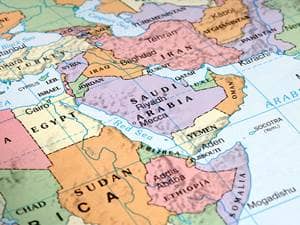
The differences between Sunni and Shiite Muslims vary, both theologically and in terms of practice in Islam, thought the divergence began with a disagreement about leadership succession. When it comes to practice, the variations are slight: Both Shiite and Sunni Muslims follow the five pillars of Islam, and uphold similar understandings of daily life and rituals. The impermissibility of eating pig, for example, is shared between both groups, as are many rules about what to consume, how to pray, and other daily matters of Muslim observance. Nonetheless, the differences exists. Shiite Muslims, for example, pray with their hands at their sides, while Sunni Muslims place their hands on their stomachs. Shiite Islam has a more formal religious structure of authority, and holds to a tradition of infallible leaders after the age of the Quran, venerating leaders as saints in a way that is not done in Sunni Islam.
Historically, the differences are almost as old as the religion itself. Shiite and Sunni Muslims diverged in the year 632 AD, when the Prophet Muhammed, considered to be the founder of Islam, died. After his death, there was no clear successor to what had very quickly become a powerful and growing religious movement in the Arabian peninsula. One group, which eventually become the Shiites, supported Ali, the son-in-law and cousin of Muhammed, as the next leader. The Shiites believed that the position should go to someone who was a direct relative of Muhammed. The other group, which would become the Sunnis, felt that blood relations was unimportant, and should not be a factor in decided succession. The Sunni Muslims wanted the position to go to a leader who was best equipped to continue the expansion of the faith. This is the split that initially made the Sunni and Shiite camps diverge from one another.
In terms of size, there is little direct comparison between the two groups. Almost all of the Muslims in the world today, about 90 percent, are Sunni Muslims. This means that in most places where one might encounter a Muslim population, it is likely that the way of Islam they practice is Sunni Islam. However, the Shiite population—about 200 million people, or about 10 percent of the world’s Muslim population—live in concentrated communities, mostly in the Middle East. For example, Shiite Muslims are the majority Muslim denomination in Iran, and have large communities in Syria, Lebanon, and Yemen. Therefore, most Shiite Muslims do not necessarily experience their denomination as a minority, since many of them live in countries where Shiite Islam is the majority practice of Islam.
Most Shiites today belong to the ‘Twelver,' or Imami branch. This was the tradition that developed after the death of Ali, and which assigned religious leadership to a series of twelve male descendants of the Prophet, starting with Ali and proceeding through his descendants. The centrality of blood relation to Muhammed remained an important factor in Shiite leadership for generations after the death of Muhammed. For a long time, these leaders were both the religious and political leaders of the Shiite Muslim community. They were considered to be infallible religious authorities, but eventually their political obligations vanished from the role, and within a century and a half of Muhammad's death they gave up any political ambitions all together. The last of these twelve male descendants of the Prophet disappeared into mystical seclusion in 874 CE, waiting to return as a messianic figure at the end of time. Since the disappearance of the twelfth imam, Shiite scholars act as regents in his stead. Such a tradition does not exist among Sunni Muslims.
11/15/2023 12:12:13 AM










